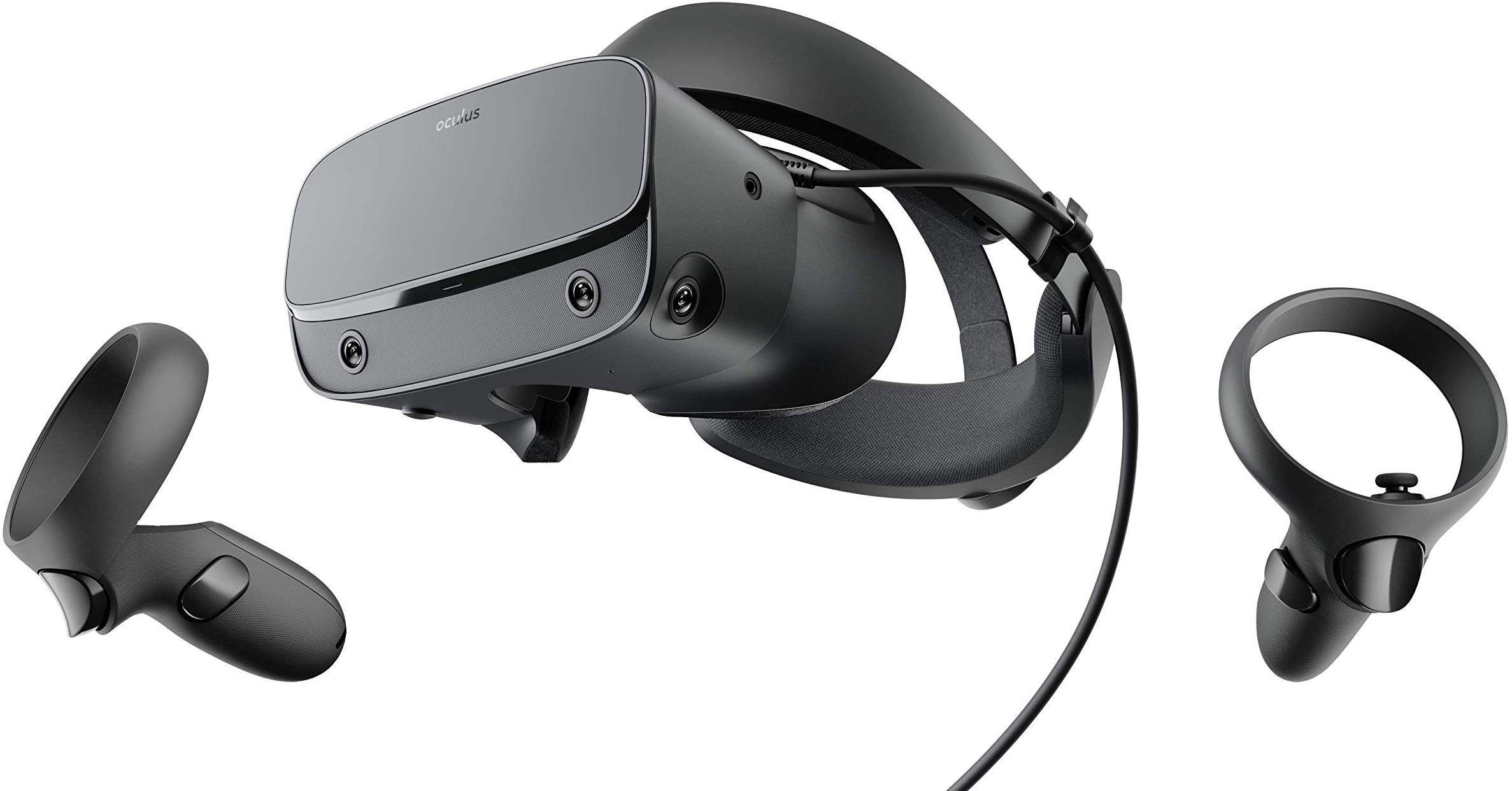Oculus Rift S Review

- Top VR gaming library: Blast, slash and soar your way through the top library in VR gaming. Oculus Rift S lets you play hundreds of games and exclusives already available in the Oculus store, with so much more to come.
- Improved optics: Stare down the competition with next-generation lenses and a sharper display. Improved optics deliver bright, vivid colors and reduced “screen-door” effect.
- Ergonomic design: Keep your head in the game thanks to a Halo headband redesigned with speed in mind. Rift S stays securely and comfortably in place with a quick twist of the fit wheel, so it can take-or double take-your fastest reactions.
- Oculus touch controllers: Arm yourself with our updated Oculus touch controllers. Your slashes, throws and grab appear in VR with intuitive, realistic precision, transporting your hands and gestures right into the game.
- Oculus insight tracking: take a step forward with Oculus insight. It translates your movements into VR No matter which way you're facing and provides room-scale tracking without external sensors.
Oculus Rift S: Quick Overview
VR has undergone many changes since Palmer Luckey first introduced us to the fascinating Oculus Rift 7 years ago. The Oculus Rift played a significant role in making VR seem real. Now owned by Facebook, the new kid on the block, the Oculus Rift S, is the company’s latest shot at high-end, PC-based VR experience. Intended as a replacement of the Oculus Rift which is now discontinued, the Rifts S has many bells and whistles that make it in some ways superior to its predecessor. Keep reading to understand the welcome enhancements including the all-new design, display and change in tracking.
Features: 4.5/5
Controls: 5/5
Resolution: 5/5
Price: 4/5
What We Like
- Cross-play support and plenty of content
- Insight tracker
- Space for glasses
- Easy to set up
- Backward compatible
- Comfortable for its weight
- Improved visuals
- No external sensors to configure
What We Don’t Like
- Prone to crashing
- Non-removable cushions
- Wired
- Reduced refresh rate
Oculus engineered many mechanisms to make using the Rift S a great experience. With a focus on ease of use, this device connects to your PC over a DisplayPort connection and a USB 3.0 port. A lengthy cable (5m) tethers to the machine, which may be limiting in terms of free movement. You then run the Oculus desktop software that guides you through the setup. While the Rift and the Rift S are pretty similar at a high level, there are still a few notable differences, some good, some not too good. Either way, there is a lot to like about this headset as you will see below.
Who is this product for?
The manufacturers of Rift S aimed to make VR more accessible and playable than ever. This product is for people who want to take a shot at VR for the first time. It is a lot easier to configure and does not need strategically placed tracking sensors. Also, it is reasonably priced compared to its competitors.
What’s included?
To effectively use the Oculus Rift S, the setup has to be complete. As mentioned, set up in this headset is a far bit easier than its predecessor. Inside the box, you’ll find the headset, some leaflets and 2 slightly redesigned Oculus Touch controllers. With this model, there are no ridiculous external sensors needed to use the headset. You have to power the controllers with 2 AA batteries, 1 for each. You are only required to plug in a USB cable and single DisplayPort adapter from the headset and you’re good to go!
Overview of features
The tracking system is the biggest change. The Oculus Rift S did away with external motion tracking sensors in favor of ‘inside-out” tracking system. On the original Rift, you were required to use up trail cables around your room and USB ports on your PC. The Rift S uses a new Insight tracking system which doesn’t require any external sensors. The 5 cameras in Rift S track movements of the controllers in your hands and your position in the room. This eases up the set-up process and tracks a player in all directions and across larger spaces.
Right from the box, you get a pair of improved Touch controllers. The redesigned controllers are not very different from their predecessor, at least when playing. A notable difference is the slightly different button layout. Instead of sitting at the bottom, the tracking ring now sits at the top. This shouldn’t be too big of an issue. The handle of the new controllers feels more ergonomic. Also, rather than being rechargeable, the controllers use a single AA battery each. You can install the battery under a magnetic cover on the handle.
To keep things comfortable, you get a halo-style ring that rests around the top of your head. The ring tightens with a wheel at the back. For added comfort, there’s a soft foam that’s permanently affixed to rubber facial interface. This is another disappointing aspect of this headset. The cushions material isn’t moisture resistant, and they become a sodden mess after a few rounds of an active game. Their non-removable nature makes it hard to clean or replace them.
The design of this headset has been heavily influenced by Lenovo. When it comes to sound, Oculus did away with over-ear earphones in favor of directional speakers in the headband. The speakers pump audio towards your ears and at the same time allows you to listen to what’s happening in the real world. There’s a 3.5mm jack that lets you plug in your own headphones.
Screen-wise, you get a dual fast-switch LCD screen with a 2560*1440 resolution, compared to the combined resolution of 2160*1200 in the original rift. The single-display means that the Rift S cannot offer mechanical IPD adjustment. To take care of this, Oculus provides software to calibrate the IPD spacing. Rift S display features an RGB stripe sub-pixel array meant to minimize screen door effect and improve image clarity.
The refresh rate is reduced to 80Hz, despite the higher pixels. This move is intended to keep the price down while not compromising on the minimum specs. Also, this way more people can get on board without necessarily having to upgrade their PC gear. The downside to this is that when the screens don’t update at a favorable refresh rate, you are likely to suffer from VR induced motion sickness.
The Rift S is completely backward compatible with the original Rift titles. This means if you own a Rift, you can play games released for the Oculus Quest and Rift S, with some small exceptions of course. With games like Lone Echo, Robo Recall, From Other Suns and the upcoming Asgard’s Wrath, Oculus’ own content library is growing and worth of attention.
In addition, the Rift S supports SteamVR out of the box. Between the 2 stores, that basically means that the Rift S has access to an extensive range of PC VR content. For the vast majority of users, the tracking in this headset is going to be absolutely good enough for many titles.
Alternative
- STEAM VR 2.0 TRACKING - From seated to standing to full 22’11”’ x 22’11” room-scale. Ideal for multi-user environments for sub-millimeter tracking accuracy
- HIGH RESOLUTION DISPLAY - Dual-OLED displays with industry leading resolution of 2880 x 1600 pixels for unparalleled visual fidelity of graphics, text, and textures
- SPATIAL AUDIO WITH NOISE CANCELLATION - Hi-res, high impedance headphones, 3D spatial sound with active noise cancellation for an immersive experience without distractions from real-world sounds
- MULTI-USER AND EXTENDED USE – Even weight distribution of the headset, easy on and off, and adjustments for head size, glasses and interpupillary distance (IPD) makes multi-user and extended use easier than ever
- VIVE TRACKER ECOSYSTEM – Expand business use cases by adding real-life objects to VIVE Tracker bringing the object into your virtual simulation. Ideal for motion capture, automotive, aerospace or heavy equipment simulation.
Despite the ease of set-up, some users complained of stability issues. If you want a more immersive experience and have both the hardware and financial resources for it, try the Vive Pro. The HTC Vive Pro headset has a refresh rate of 90 Hz and a 110 degree field of view (FOV). It has a resolution of 2880*1600 pixels combined (615 dpi) with an AMOLED screen for each eye. It also comes with built-in on-ear headphones and microphone. For comfort, the Vive Pro has more plush cushioning around its entire faceplate. The cushion is easy to clean and you can replace it when it wears out.
Tutorial
Here’s an in-depth unboxing and setup tutorial video (https://www.youtube.com/watch?v=S7bniNtuYsc ) to help you in operating the Oculus Rift S better. Be sure to check it out for more convenience.
Conclusion
Despite ignoring some of the original’s selling points, there is a fair bit to like about this headset. The minor design changes and visual enhancements, like the addition of cameras in the Rift S has made setting up a breeze. You no longer have to struggle with positioning external sensors to track you, making it exceptionally easy to calibrate your play space. If you are shopping for your first VR setup, the Rift S is worth considering.


